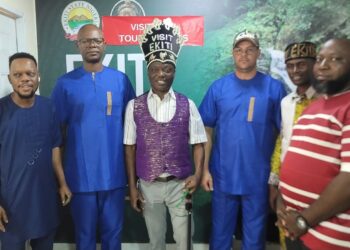Imeko, located in Imeko Afon Local Government Area in the west of Ogun State, Nigeria, bordering the Republic of Benin, is only known as the pilgrimage city of the Celestial Church of Christ (CCC).
Imeko-Afon, once a great town and its people, languished in relative obscurity despite its intimidating and enviable profile during the Colonial era, its proximity to Abeokuta, the seat of power, and even some decades in the post-colonial era.
The road leading to the town from Abeokuta is snake-like, hilly, and dusty. Steep inclines disfigure the road, causing serious headaches to those who traverse it. For them, the rainy season is always painful and painful.

Imeko: Colonial Era Till Date
IN 1891, what is known as Yewaland in Ogun State today cut across every section where the Yewa river starts into the lagoon: that is, from Imeko District down to Idogo in Ilaro area, and from Idogo to Ado, to Badagry, into the lagoon. From Badagry down to Imeko and up to Oke Ile, Ijio, Oyo State was called the Western District of Lagos Colony or Meko District: that is the macro Meko District, with Meko as the administrative headquarters, between 1891 and 1905.
In 1906, the first amalgamation of the Southern part of Nigeria came up: the colony of Lagos; the Western District of Lagos Colony; the Western Protectorate (that’s the remaining part of the Yorubaland); the Niger Delta Protectorate and the Eastern Protectorate were merged to form the Southern Colony of Nigeria, which later became the Southern Protectorate of Nigeria. This was divided into three provinces: Western, Central, and Eastern, respectively. The Western Province, which was the whole of Yorubaland, was divided into 11 and a half: Lagos, Epe, Ikorodu, Badagry, Ijebu Ode, Meko, Egba, Ilesa, Ondo, Oyo, Ibadan and Osogbo Sub-District. This is the medium Meko District as described in the Executive Council Orders numbers 27 of 1908 and 2 of 1909, Colony of Southern Nigeria Order in Council, made under The Supreme Court Ordinance (Statute Laws Revision Ordinance, 1908, Schedule 1, Chapter III (3):
“The following lines and natural features constitute the boundaries taken in their respective order, commencing at the junction of the ‘Oke-Ile’-Wasimi Road with the River Okpara. The said road is as far as its intersection with the Oyan River. The Oyan River to its junction with the Egba boundary. The Egba boundary westerly to an iron Pin on Aro-Meko Road in the vicinity of Ewon (Idi-Emi), today is known as Ago-Owo quarter in Ayetoro, bearing 248ⁿ 30′ and distant 12.7 links from a tree marked M.A. The Egba boundary is southerly to its junction with the boundary of the Badagry District—the Badagry District’s boundary to its intersection with the boundary of the French Colony of Dahomey.
There was another restructuring in 1914: the amalgamation that formed Nigeria, thereby merging the Southern and Northern Protectorates. The new restructuring came with the issue of division, and the early provinces were re-divided, thereby creating the Western Province, which was earlier divided into 11 and a half Districts as Abeokuta, Ijebu Ode, Ondo, Oyo, and Ibadan provinces, with Lagos as the capital of the just-created Nigerian territory.
The creation of divisions over districts led to the elevation of specific district headquarters to divisional headquarters, such as Abeokuta, Ijebu-Ode, and others. At the same time, the newly established Ilaro Division rank-shifted the Meko district. In 1906, the district headquarters of Abeokuta, Ijebu Ode, Ondo, Oyo, and Ibadan, ranked alongside Meko in the old Western Province of the Southern Colony, transitioned into Provincial Headquarters. Others like Epe, Ikorodu, Ilesha, and Badagry became divisional headquarters. Oshogbo, a sub-district headquarters, became the provincial headquarters, and today, Oshogbo is the state capital in modern-day Nigeria alongside Abeokuta, Ibadan, Lagos, and Ondo. Even Ekiti, which was not listed as one of the early districts’ headquarters for the Western Province of the Colony of Southern Nigeria, is now a state capital.
Others mentioned above are cities of great importance today in the southwest part of Nigeria. They are paramount seats with substantial landmark educational institutions.
Where is the place of Imeko (Meko, Mekkaw, Mekko) today? Neglected, abandoned, but not deserted by her children!
A town that was the administrative headquarters of the then Western District of Lagos Colony (1891-1906) stretched from Badagry to Oke-Ile/Ijio and Idi-Emi (Ewon) to Wasinmi, Jabata and River Okpara, the boundary with Shane in Dahomey now the Republic of Benin. The Colony or Protectorate of Southern Nigeria was created in 1906 and divided into Western Province, Central Province, and Eastern Province. The Western Province (1906-1914) was divided into the following districts: Lagos District; Epe; Ikorodu; Ijebu Ode; Badagry; Meko; Egba; Ondo; Ilesha; Oyo; Ibadan, and Oshogbo subdistrict
Egba District, Meko District, and the remaining part of Badagry District formed Abeokuta Province. Badagry and a few other towns established the Badagry Division under the new capital town of the old Lagos District. Meanwhile, the remaining portion of Badagry District, spanning from Ado-Odo, Igbesa, and Ipokia Idiroko to Ilaro, Igbogila, and the newly established settlement of 11 war-devastated communities of Ayetoro, established in 1904, merged with Meko and Egba districts. This resulted in the formation of Abeokuta Province, which was further divided into two divisions, the Egba and Ilaro divisions.
Meko, the second largest community in the Ketu Kingdom, has been under British rule since the European scramble for Africa. Since the time of Alaketu, Meko has traditionally been autonomous from Ketu. In 1867, Adiro Olumaja (1858-1867) sought asylum in Imeko during the Onimeko Oyefi Akanku Koledoye (Akanku 1), the Meko-Egba War, and the Egba-Ewon War of 1868 and 1868, respectively. Generally, Imeko emerged as the leading Ketu Community in Nigeria following the Dahomey war that sacked the town in 1882. It was the first to establish a police quarter in what is now known as Yewaland, the first to have a district commissioner’s compound, the first to have infantry and elementary education, the first to have a district court, the first to have a prison, the first to have a psychiatric hospital annex, the first to have a forestry reserve, the first to have the West Africa Frontier Force
Today, we’ve relocated all these iconic institutions, including the first ones! Imeko currently resides in a place of past glory! The once great town is now nothing but a shadow of herself!
And the song on the lips of the people of the town has since been: “Federal Government, come to our aid; State Government, where is our portion of development?”
The division, Ilaro, once again split into 11 districts, retaining Meko as a district (now known as the micro-Meko District). The districts included Meko, Eggua Ajilete, Oke-Odan, Igbesa, Ilaro, Ayetoro, Ipokia, and Ado Odo.
And that marked the beginning of neglect and regression of the once great Imeko! The town, which was well reckoned with by Great Britain (as the Onimeko and his chiefs were being updated by any development in Great Britain, as such, when the King of the United Kingdom, Great Britain and Ireland and His Majesty, King Edward VII died June 26th 1830 and when George Frederick Ernest Albert, George V, was to be installed June 22nd, 1911, the Onimeko and his chiefs were informed respectively), could be said to now live in the shadow of itself and glory of her past.
The retrogression was further propelled by the dethronement of the Onimeko, Oba Adegbola, who succeeded Oba Durodolu (Akanku II).
In the 1940s, the first secondary school was to be established in Imeko because there had been a primary school, Wesleyan Mission Infantry and Primary Classes. The proposed secondary was relocated to Ogbe in Abeokuta.
As if Imeko had not suffered retrogression enough, the advent of politics later made Imeko’s oblivion deeper with the Action Group and National Council of Nigeria and the Cameroons (NCNC), as the town was in the opposition party. As a result, the Action Group made all the heads of the villages (Baales) under Imeko substantial kings due to the low level of Western education literacy of the then Onimeko.

It is of note that Akanku I and his chiefs left three forest reserves on August 25th, 1908, which were recorded in the gaze: Meko Forest Reserve called Omodoidose, Abafon; Oha. The son of Oba Durodolu, Oba Okunade Durosinmi Oyekan (Akanku II) became king in 1926 and also left a forest reserve, Meko Extension at Jabata.
In 1938, all the crowned kings of Imeko’s villages were required to pay tributary taxes to the Onimeko, who were their leaders.
Even during the 1930s, when the old Egbado North and South local governments were established, Meko was not recognized as a local government until 1996, when the Imeko/Afon Local Government existed. It should be noted that Afon was a village under Imeko at the time.
According to the population results released by the Europeans in 1909, Imeko had a population of 5,000, Idofa had 600, and Ijohun had 400. Ijale-Ketu had a population 300, while the results classified all other towns as “ordinary villages.”
Oba Benjamin Oyeditan Olanite (Akanku IV), the current Onimeko of Imeko, recently stated in a conversation with journalists at his Imeko house: “There were numerous anomalies against Imeko.” For instance, during the creation of states, Oyo State claimed another piece of Imeko’s land, Asunnara and Waasimi, due to a lack of records.
The monarch expressed concerns that the Nigerian government at all levels should not leave Imeko, a community of such great historical importance, undeveloped.
Tourism attractions:

Other tourist sites in the town include Amule Rock, where people hid during the Franco-Dahomean War between 1882 and January 1894; Ikanun Mountain; Iyanka Rock; Ijagure cave and mount; Igbogbo Rocks Abeba Mount; the tomb of the founder of Celestial Church of Christ (CCC), Rev. Samuel Biléhou Joseph Oshoffa; tomb of a foreign Traveling Commissioner, Captain Vere De Creighton, who died of malaria in 1899 (where Nigerian Armies always pay him homage every year); Osuru Stream Water (which was a waterfall before the rock collapsed); Osunle, which the Ogun State government promised to develop since 20 years ago; Ogunndoko; Ogbun Aseere; Iyabe Jerry Tunnel, which has layers and steps into a path that leads to Igbaleaye in Benin Republics; Erinfu Waters; and Aroketu, to mention a few.
“The government’s neglect has turned the Meko forest reserves into a haven for criminals, despite their intended use as game reserves. People from the Republic of Benin are now freely entering the forest reserves and causing destruction.
“Imeko is a pilgrimage centre for members of the Celestial Church of Christ (CCC).” Every year, the church organises two significant events in the town, but the road to Imeko is exceptionally narrow and largely unpaved.

Being a border community, all the federal security agencies are present here, and the Customs make good revenue for the government herein. Yet, we have been so neglected that we are not part of the country.
As a border community, closer to the Benin Republic, but without any security headquarters, the town has become a sure escape route for miscreants,” Oba Olanite disclosed.
While decrying the neglect of government, both at the state and federal levels, among the 11-and-a-half headquarters the Europeans formed far before independence, the Onimeko said the town was at par with Ijebu and Egba in those days.

Oba Olanite, who described Imeko as a town where a federal high court should be located, enjoined the state and the federal government to help the community, saying, “We don’t have tertiary institutions, nor do we have technical educational institutions.
“Imeko has excellent potential to be the pride of Nigeria if well attended to, even at the pace of development with the towns it used to rank with.
“We’ve got land.” We once gave 4,000 acres of land to the then Western Region government, now taken over by the Oodua Group of Companies. We had a series of meetings with the company’s Group Managing Director, and he promised to come and do something about it, but the promise has remained rhetorical.
“Our land is the best for cotton in Africa. That was why the British Cotton Grower Association (BCGA) chose Meko as its headquarters town. Our land is ideal for tomato and maize plantations, and our people, primarily farmers, are eager to explore these opportunities, provided the government supports and motivates them. This has a vast potential to turn around the economy of Ogun State and Nigeria.
It was during the late General Sani Abacha government, with President Muhammadu Buhari as the Chairman of the Petroleum Trust Fund (PTF), that the only federal road (Imeko-Aro road) of 1900 (Now Abeokuta-Imeko Road) rehabilitated and reconstructed. Today, the road is an eyesore, totally abandoned and in much worse condition. Other roads included Imeko-Ebute-Igboro-Idi-Iroko-Badagry Road of 1918 (Now Ilara/Ijoun/Ilase Road), Ayetoro-Imeko that was constructed in 1952, Imeko-Oke-Ile/Ijio Road of 1952, Imeko-Gangan Road of 1952, and Imeko-Idofa/Ilara Road of 1953/1954.
Ogun State still has another 232 acres of land in Imeko, which the government earmarked for Leadership Development Institutions since the late 1970s, but nothing has been done on it. The state also has land for a housing corporation since 1976, yet nothing has been done with the land,” Oba Olanite resorted to.











